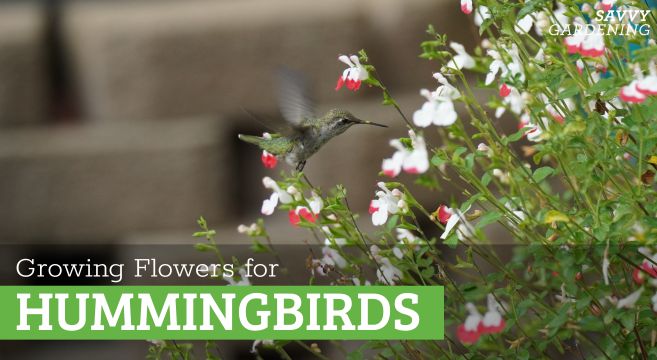This post may contain affiliate links. If you make a purchase through links on our site, we may earn a commission.
I first realized I had attracted hummingbirds to my yard when I was gardening. Earlier in the season a few years ago, I had picked up a packet of ‘Pastel Dreams’ zinnia seeds and planted them in one of my raised beds. That summer, as I weeded and harvested, I would spot something flitting about out of the corner of my eye. I soon realized it was a hummingbird attracted to the profusion of zinnia blooms. Since then, I have planted a whole buffet of hummingbird flowers that also attract a variety of other pollinators, like bees and butterflies, to my gardens.
Choosing hummingbird flowers for your garden
A great place to start when choosing hummingbird flowers is to look for red tubular blooms. This is because a hummingbird’s retinas cause them to see more red and yellow tones. However, according to the National Audubon Society, the quality of the flowers is what really matters. So while red and yellow flowers can attract these magical little birds to your garden, once there, they’re not picky when there is a variety of other nectar-rich blooms to offer lots of sustenance. Native plants are a great place to start, and often provide the best nectar sources. Try to establish a bloom time in your garden that extends from spring through fall.
Besides flower nectar and any special feeders they may encounter, hummingbirds also snack on small insects—flies, gnats, small spiders—for protein. So your garden can provide plants to attract this part of their meals, too. And hopefully, the environment you create will also encourage them to build nests.

In my book, Gardening Your Front Yard, I included a unique front yard where you couldn’t see any plants (they were all planted behind tall hedges), but the house itself had been painted white with red polka dots to attract hummingbirds to the neighbourhood. Spolier alert: It worked! I included a photo in this article on pollinator garden design.
Here are a few hummingbird flowers to consider for your garden.
Cypress vine (Ipomoea quamoclit)
This vining plant with its feathery leaves falls firmly in the “red tubular flowers” category. And while cypress vine may be poisonous to humans, hummingbirds love the blooms, which can be red, white, or pink. Deer resistant, with feathery foliage and flowers until fall, watch it climb at least six to 10 feet (maybe even 20) up a wall or trellis.

Fuchsia
You almost have to stand underneath a fuchsia plant to fully appreciate the flowers. Which is why they make great hanging basket plants. A hanging container also makes it easy for hummingbirds to feast. Long-lasting blooms will grow in both shade to full sun (check the plant tag), and come in a multitude of color combinations.

Cardinal flower (Lobelia cardinalis)
Hardy down to USDA zone 3, this native plant that’s part of the Bellflower family will thrive in full sun to part shade. Because of its tubular-shaped flowers, it actually relies on hummingbirds and bees for pollination. My neighbor gave me some seedlings a couple of years ago and I have a nice little “patch” in one of my backyard gardens. I find the plants really stand out when planted in a group.

Anise hyssop (Agastache foeniculum)
Native to North America, this perennial member of the mint family is also called hummingbird mint. It’s worth mentioning it spreads by rhizomes and self seeds. Drought tolerant once plants are established, Anise hyssop will thrive in full sun and dry soil. Deadheading the purple flowers will encourage more blooms.

Crocosmia (Montbretia)
Crocosmia is a spring-planted corm that you’ll find in the bulb section of your local nursery or online retailer. As it starts to grow, the foliage is upright and fans out, like an iris (it’s a member of the same family), but the stems of tubular flowers are very unique—and hummingbirds are drawn to them! Some varieties of crocosmia are winter hardy in USDA zones 7 to 11, but ‘Lucifer’ will survive down to zone 5.

Salvia
There are a LOT of salvias, both annual and perennial (depending on where you live), that you can choose to include in a pollinator garden. They love full sun and while they’re considered to be tasty according to hummingbird standards, rabbits and deer aren’t fans. Jessica’s favorite varieties include ‘Wendy’s Wish’ and ‘Lady in Red’.

Passionflower (Passiflora incarnate)
Passionflowers look like something a cartoonist would draw for an alien landscape. They are such an interesting bloom with unique features that are unmatched—and attractive to hummingbirds. Give them a fancy obelisk or trellis in full sun to part shade and their tendrils will help them climb.

Zinnias
I grow zinnias from seed every year, and they are always covered in pollinators. You really can’t go wrong. Start them from seed to give seedlings a head start, or direct-sow once all threat of frost has passed. Zinnias grow to be anywhere from a foot (dwarf varieties) to three to four feet tall (the aforementioned ‘Pastel Dreams’.

A few more hummingbird flowers for your list
- Bells of Ireland
- Hardy hibiscus
- Trumpet vine
- Torch lilies
- Weigela
- Nemesia
- Coral honeysuckle (Ionicera sempervirens) aka trumpet honeysuckle
- Larkspur
- Cosmos
- Penstemon
- Bee balm
- Rose of Sharon
- Foxglove




Leave a Reply